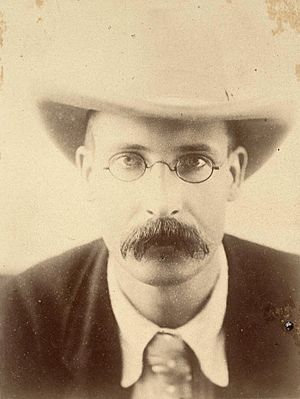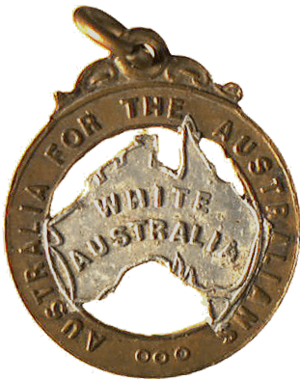William Lane facts for kids
William Lane (born September 6, 1861 – died August 26, 1917) was a journalist and writer from England. He was a strong supporter of workers' rights in Australia. He also believed in a perfect society, a concept called utopian socialism.
Lane was born into a family that faced financial struggles in Bristol, England. He was a very good student. He moved to Canada and worked as a linotype operator, which is a type of printer. Later, he became a reporter for the Detroit Free Press. There, he met his future wife, Ann Macquire.
After moving to Australia with his wife, child, and brother John, he became very active in the Australian labor movement. This movement worked to improve conditions for workers. He helped start the Australian Labour Federation. He also wrote many articles for newspapers that supported workers' rights. He wrote about topics like fair treatment for workers and ideas about national identity.
Later, Lane became unhappy with Australian politics. He felt that the labor movement was not achieving its goals. So, in 1892, he and a group of people who shared his dream of a perfect society moved to Paraguay. They wanted to build a new community called New Australia. They hoped to create a society based on his utopian ideas. However, there were disagreements within the colony. In May 1894, he left to start another colony nearby called Cosme. He eventually left this project too in 1899.
He then moved to New Zealand and continued his work as a journalist until he died in August 1917. After his death, some people praised him as a hero of utopian socialism. Others criticized him as an arrogant leader whose projects failed. Because of his strong political views and long career, he is still a debated figure in Australian history.
Contents
Early Life and Education
William Lane was born in Bristol, England, on September 6, 1861. He was the oldest son of James Lane, a landscape gardener, and Caroline Hall. William was born with a clubfoot, which caused him to limp even after it was partly corrected later in life. His father, James, struggled financially when William was young. However, he later improved his situation and became an employer.
Young William went to Bristol Grammar School. He was a very talented student. But he had to start working early as an office boy. When he was 14, his mother passed away. At 16, he moved to Canada. There, he took on various jobs, including working with a linotype machine. During this time, he became very interested in the writings of economist Henry George and socialist Edward Bellamy. By 1881, at age 24, he became a reporter for the Detroit Free Press. He married Ann Macquire on July 22, 1883.
Journalism in Australia
In 1885, William and Ann Lane, along with William's brother John and their first child, moved to Brisbane, Australia. William quickly found work as a writer for the Queensland Figaro newspaper. He then wrote columns for the Brisbane Courier and the Evening Telegraph. He used different pen names for his articles.
As the Australian labour movement grew, Lane's columns, especially his "Labour Notes" in the Evening Telegraph, began to strongly support workers' rights. Lane started attending meetings and speaking out against unfair laws. He also spoke against Chinese immigrants, using an American accent he had picked up.
Lane later became the main editor of the Sydney Morning Herald. In November 1887, he left that newspaper to start his own weekly paper called The Boomerang. This newspaper was known for its lively style and strong pro-worker messages. It also contained strong anti-immigrant views. Lane was a big supporter of Emma Miller and the idea of women's suffrage, which meant women getting the right to vote. He believed strongly in Henry George's idea of a Single Tax. Lane became more and more dedicated to creating a completely different society. He eventually left The Boomerang because it was privately owned.
In May 1890, he started The Worker, a weekly newspaper funded by trade unions. This paper's language became very critical of employers, the government, and even the British Empire. After workers lost the 1891 Australian shearers' strike, Lane became convinced that real social change needed a completely new society. The Worker then focused more on his idea for a utopian community called New Australia.
Lane's Writings and Views
Even though he mostly wrote non-fiction, William Lane was also an author. His books showed his political ideas. One of his novels was The Workingman's Paradise. He wrote it to support the workers involved in the 1891 Australian shearers' strike. It was published in early 1892 under the name John Miller. In this book, Lane suggested that anarchism was the best way for society to be organized. Through the main character, he shared his belief that society might need a period of state socialism before reaching an ideal state of anarcho-communism. Mary Gilmore, a famous Australian writer, said that the book was true to their conversations and had historical value.
His most well-known short novel is White or Yellow?: A Story of the Race War of A.D. 1908 (1887). In this story, Lane imagined a future where many Chinese people would legally come to Australia. He wrote that they would take over industries and resources in the "empty north" of the continent. This book was part of a type of Australian writing called "invasion literature." It showed Lane's nationalist and racial views. It also reflected his left-wing politics within a fictional future where Australia was under attack by the "Yellow Peril" (a term used to describe fears of Asian immigration).
Lane wrote that in the near future, British business owners would use the legal system to bring many Chinese workers to Australia. He believed this would happen regardless of the problems it would cause for Australian workers and society. He imagined that the economic and cultural conflicts from this would lead to a race war across the continent. This war would be fought between White settlers and Chinese workers.
Historically, leaders of Australian labor and trade unions were strongly against bringing in Chinese workers. They saw them as a threat to jobs because they would work for lower wages. They also saw them as a threat to their culture. Lane's book aimed to unite white Australians based on their race.
New Australia Colony
William Lane disagreed with some Australian labor activists. He turned down an offer from the Queensland Government for land to create a utopian settlement. Instead, he started a campaign across Australia to create a new society somewhere else in the world. He wanted this new place to be filled with strong, sober Australian bushmen and their proud wives.
They eventually chose Paraguay. Lane and his family, including his brother John, along with hundreds of followers (238 people in total) from New South Wales, Queensland, and South Australia, traveled to South America. The first group of pioneers left Sydney on the ship Royal Tar on July 1, 1893. A second group sailed from Adelaide on the last day of 1893. Both journeys went to Montevideo, Uruguay. From there, they had a difficult overland trip to Paraguay.
The New Australia colony soon faced problems. These included issues with relationships between different racial groups (Lane did not approve of relationships with the Guarani) and alcohol. Lane's strict leadership style quickly made many people in the community unhappy. By the time the second group of utopians arrived from Adelaide in 1894, Lane had left. He took a small group of loyal followers to form a new colony nearby called Cosme.
Eventually, there were many criticisms and disagreements about Lane's leadership. A strong dispute arose between two main groups in the colony. One group supported Lane's decisions, and the other was very critical. Lane became disappointed with the whole project. He willingly left Colonia Cosme and returned to Australia in 1899.
Many important people were born and grew up in the New Australia settlements. This includes the famous comic book writer Robin Wood. Anne Whitehead's 1997 book about New Australia, Paradise Mislaid, has a chapter about Robin Wood's childhood with his Australian-Paraguayan family. Today, there are as many as 2,000 people of Australian descent in Paraguay.
Later Life and Legacy
Lane left Cosme with his family on August 1, 1899. He returned to Australia and briefly worked as an editor for the Sydney Worker. Then, he sailed to New Zealand. After feeling sad for a while, he soon regained his energy. From 1900, he became a feature writer for the New Zealand Herald. He wrote under the pen name 'Tohunga', which is a Maori word for prophet. However, his views had changed. He became very conservative and strongly supported the British Empire. He kept his strong dislike for East Asians, which he had shown in his earlier writings. During World War I, he developed very strong anti-German sentiments.
William Lane died on August 26, 1917, in Auckland, New Zealand, at the age of 56. He had been the editor of the Herald from 1913 to 1917. He became a much-admired person in New Zealand.
Before his own death, Lane had lost two sons. Charles died at a cricket match in Colonia Cosme, Paraguay. Donald died on the first day of the ANZAC landings (April 25, 1915) at the beaches of Gallipoli.




